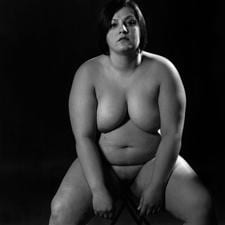Posing nude — and having those photos put up for public display — could be an anxiety-provoking prospect for the most confident among us. For Cristina Costa it was a step on the path toward accepting her body exactly the way it is.
“Body issues are something that I’d been struggling with for so long,” says Costa, who posed for the exhibit This Is My Body: Portraits of Women with Body Issues by local photographer Steve Stober and up now at G+ Galleries. “I left home a size eight when I was 18 years old. Later I was a size 14, which my family couldn’t accept, and for the last two years I’ve been a size 16.”
She says her family sees her weight as an obstacle to her success. “They love me and want me to find a man,” she says. “They think my body is keeping me from being really happy. They don’t see anything else holding me back except my body.”
Costa adds that coming out as queer has made it easier to reject mainstream ideals of weight and beauty.
“I have a partner who loves me and my curves,” says Costa. “It’s helped being around the queer community. There is a different acceptance, I felt safe. I did burlesque and that was great because you can do it with any body type.”
But for larger women coming out is no guarantee of finding acceptance or being seen as attractive.
“I’m overweight, I’m plump,” says queer woman May Lui, a former manager and now board member at the Toronto Women’s Bookstore. “I’ve gained more positive words like ‘curvy.’
“I am in my 40s now and I came out close to 20 years ago. What I had hoped I’d find in the queer community was a greater acceptance of larger women. I didn’t find that. At pickup places and bars there was a strong ideal toward a body type that reflected the mainstream. Why do we replicate mainstream values in the queer community?”
She says that being thin isn’t the only mainstream value queer women cling to. “I do not see a great deal of myself reflected in the community,” says Lui, who is mixed race. “We need to broaden our own minds about who is beautiful and who isn’t. Beauty is a raced, classed, gendered ideal.”
Photography has also helped Lui to recognize her own beauty.
“My current partner is a photographer,” she says. “At one point we decided to take nude pictures of me, then she gave me this gift of beautiful black and white pictures. It was one of the first times I had looked at photographs of myself and loved them and felt, ‘Wow, I’m beautiful.'”
Queer performance duo Fat Femme Mafia (FFM) is also using art to encourage queers to think of fat as beautiful.
“Fat is queer,” says Chelsey Lichtman, “because it doesn’t fall into the norm. Body image is important, but it’s mainstream. We are radical. We’re talking about loving your fat body.”
Lichtman and fellow FFM Liz Brockest have just returned from Thunder Bay, where FFM was invited to perform and lecture at Lakehead University. It’s the kind of fat activism the two have been promoting since they founded FFM in 2005.
“Our platform is basically about visibility and creating space for people with larger bodies to get together and feel comfortable,” says Lichtman. “We’re all about putting on shiny suits and being really visible in queer spaces. We talk about how to have a different perspective on our own bodies. We discuss how the media portrays women’s bodies and we create our own representations and culture.
“Thinking about how the media dictates how women feel about themselves — it can be undone. We need to somehow create or weasel our way into mass culture to make a difference.”
Gili Haimovich, an expressive arts therapist who runs workshops on body image at Sheena’s Place, a centre for people with eating disorders, links the current beauty ideal to consumerism, something that transcends sexuality.
“We have to remember that what is represented in the media is very narrow,” says Haimovich. “Also thinness is not equal to beauty. Every period had its own model of beauty and we live in relation to the period we’re in now. In the 18th century, during the Rococo period, fat women were beautiful.
“There is a connection between wealth and image. Fat women were well fed and could spend hours posing for a painting. Today it’s, ‘Buy more products, be wrinkle-free, celluloid-free, young’ — there are links between being pretty, successful and wealthy.”
Haimovich applauds exhibits like This Is My Body that celebrate women of different sizes. “More diversity in representations is needed,” she says. “It’s important also to remember that all or most of us can enjoy our bodies no matter what the outside critical look. It shouldn’t take away our ability to enjoy our bodies.”

 Why you can trust Xtra
Why you can trust Xtra


